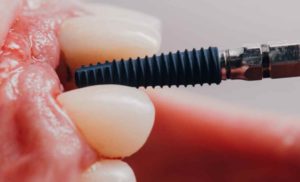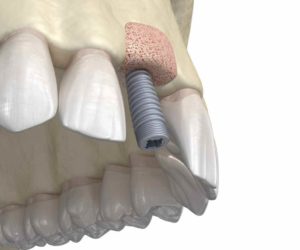If you’ve recently had a fitted dental implant, you’re likely to be aware of a process called osseointegration. The procedure of a dental implant requires close contact with the jawbone when a titanium screw is infused together with it so the crown (the tooth) is placed on top of the abutment (the base for the crown). Once fitted, the implant requires a period of patient healing for a certain number of months for the osseointegration process to be successful.
First, let’s understand what is meant by the term, osseointegration.

What Is Osseointegration?
The term Osseointegration means bone ingrowth surrounding the fitted implant. The bone cells grow towards the implant so keep it secure in place for long-term use. The osseointegration process typically lasts between four to eight weeks but may take longer depending on the health of the jawbone. The dentist may consider applying a temporary solution for the jawbone to grow if required. The end result of osseointegration is for your fitted dental implant to become stable and strong in position. This cannot be achieved without a certain period of healing.
How Does The Osseointegration Process Work?
There are four separate stages to the osseointegration process. Let’s breakdown each stage for a fitted implant.
-
Stage 1 – Hematosis
Hemotosis is the first stage of the process, which involves the oral surgeon drilling a hole where the implant is to be fitted so that the titanium screw is placed in contact against the jawbone. Blood vessels begin to rupture which is likely to cause minor bleeding to begin, but this is the initial stage of the healing process. Proteins leak out of the blood vessels adhering to the implant surface. The ruptured area (the site of the implant) will heal with something called Thrombocytes, a component of blood that reacts to bleeding within the vessel and begins to form a blood clot
-
Stage 2 – Inflammation
After implant procedure, immune functions will begin to release so that tissues, oral bacteria and chipped bone are cleaned. New immune cells like polynuclear leukocytes (pml’s) are released into the wound through the blood vessel to ward off harmful bacteria penetrating.
-
Stage 3 – Proliferation
Fibroblasts are collagen proteins used to keep a strong structural framework for tissues. Shortly after implant treatment, the third stage of the osseointegration process involves fibroblasts entering the wound to produce collagen and other fibres for overall strength. This helps to release new blood vessels and restore oxygen so that healing can continue.
-
Stage 4 – Remodelling
The final stage of the osseointegration process has arrived and the new bone structures are in place! This means that the bone structure has grown around the implant, meaning the implant is in a functional form.
 Depending on the density of the jawbone from stage 1 of the osseointegration process, healing may take a minimum period of four weeks or longer at twelve weeks. Either way, it is important that you follow oral surgeon recommendations and instructions so the implant treatment is considered successful and to ensure your implant can be fully functional for you to use. Sometimes, the osseointegration can be disturbed if healing isn’t taken seriously causing your fitted implant to become loose.
Depending on the density of the jawbone from stage 1 of the osseointegration process, healing may take a minimum period of four weeks or longer at twelve weeks. Either way, it is important that you follow oral surgeon recommendations and instructions so the implant treatment is considered successful and to ensure your implant can be fully functional for you to use. Sometimes, the osseointegration can be disturbed if healing isn’t taken seriously causing your fitted implant to become loose.
You should also make sure you visit the surgeon at certain stages of the healing process if requested. This will make sure there are second eyes on your implant that ensures the implant is healing correctly.
Contact our Woden dental centre today if you’re considering implant treatment. Alternatively, if you have questions around whether dental implants are safe, simply click here to get in touch with us or call 0262813562.


